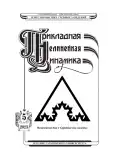Marking stages of REM and non-REM sleep using recurrent analysis
- Авторлар: Emelyanova E.P.1, Selskii A.O.1
-
Мекемелер:
- Saratov State University
- Шығарылым: Том 31, № 5 (2023)
- Беттер: 643-649
- Бөлім: Articles
- URL: https://journals.rcsi.science/0869-6632/article/view/251295
- DOI: https://doi.org/10.18500/0869-6632-003060
- EDN: https://elibrary.ru/WGHKJW
- ID: 251295
Дәйексөз келтіру
Толық мәтін
Аннотация
Негізгі сөздер
Авторлар туралы
Elizaveta Emelyanova
Saratov State University
ORCID iD: 0000-0001-5535-8921
SPIN-код: 6722-8649
ul. Astrakhanskaya, 83, Saratov, 410012, Russia
Anton Selskii
Saratov State University
ORCID iD: 0000-0003-3175-895X
SPIN-код: 7269-0414
Scopus Author ID: 54882328300
ResearcherId: A-9503-2015
ul. Astrakhanskaya, 83, Saratov, 410012, Russia
Әдебиет тізімі
- Ebrahimi F, Alizadeh I. Automatic sleep staging by cardiorespiratory signals: a systematic review. Sleep and Breathing. 2002;26(2):965–981. doi: 10.1007/s11325-021-02435-8.
- Mikkelsen KB, Villadsen DB, Otto M, Kidmose P. Automatic sleep staging using ear-EEG. BioMedical Engineering OnLine. 2017;16(1):111. doi: 10.1186/s12938-017-0400-5.
- Parro VC, Valdo L. Sleep-wake detection using recurrence quantification analysis. Chaos. 2018;28(8):085706. doi: 10.1063/1.5024692.
- Acharya UR, Sree SV, Swapna G, Martis RJ, Suri JS. Automated EEG analysis of epilepsy: A review. Knowledge-Based Systems. 2013;45:147–165. doi: 10.1016/j.knosys.2013.02.014.
- Acharya UR, Sree SV, Chattopadhyay S, Yu W, Ang PCA. Application of recurrence quantification analysis for the automated identification of epileptic EEG signals. International Journal of Neural Systems. 2011;21(3):199–211. doi: 10.1142/S0129065711002808.
- Eckmann JP, Kamphorst SO, Ruelle D. Recurrence plots of dynamical systems. Europhysics Letters. 1987;4(9):973–977. doi: 10.1209/0295-5075/4/9/004.
- Ramos AMT, Builes-Jaramillo A, Poveda G, Goswami B, Macau EEN, Kurths J, Marwan N. Recurrence measure of conditional dependence and applications. Phys. Rev. E. 2017;95(5):052206. doi: 10.1103/PhysRevE.95.052206.
- Zhu L, Wang C, He Z, Zhang Y. A lightweight automatic sleep staging method for children using single-channel EEG based on edge artificial intelligence. World Wide Web. 2022;25(5):1883–1903. doi: 10.1007/s11280-021-00983-3.
Қосымша файлдар









